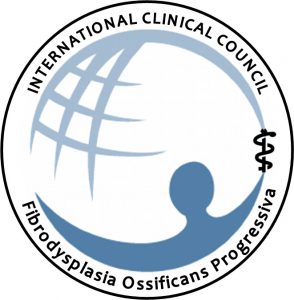Emergency Help

FOP is accelerated by trauma
Any attempt to remove the unwanted bone results in explosive episodes of new bone growth. Immunisations can also trigger additional bone growth.
Evaluate the emergency and protect the life of the patient as if FOP were not an issue.
Please always follow these emergency guidelines. If time permits, consult a specialist regarding potential risks of any surgical or medical interventions being considered.
Please refer to the International Clinical Council for FOP’s Medical Guidelines wherever time permits.
FOP Treatment Guidelines
In all cases: protect the life of the patient as though FOP was not an issue
Where possible, follow these guidelines, along with the treatment guidelines. Any unnecessary physical trauma to the patient can cause irreparable restrictions to their body and movements.
1. Avoid deep tissue trauma
Including intramuscular (IM) injections, if possible.
2. Stabilize & treat
NO IM injections but venepuncture, subcutaneous and intravenous medications are okay.
3. Take intubation precautions
Protect the jaw and get expert anaesthesia assistance since the jaw and neck may be completely or partially locked. If airway management is needed, the preferred approach is naso-trachael intubation with fibre-optic guidance. Many people with FOP have restricted jaw and neck mobility, so intubation must be done in as gentle a fashion as possible. Follow intubation with a course of steroids (prednisolone 2mg/kg/day for 4 days) to prevent fatal airway swelling from the trauma.
4. Consult expert doctors
This is strongly recommended regarding the potential risks of any surgical or medical interventions being considered.
5. Consider administering prophylactic (precautionary) steroids in cases of major trauma
Emergency Medical Contacts
Professor Richard Keen
FOP Specialist
Royal National Orthopaedic Hospital Stanmore, London
020 3947 0056
rno-tr.metabolicsecretary@nhs.net
Professor Fred Kaplan
Professor Robert Pignolo
FOP Specialist
Department of Medicine Mayo Clinic School of Medicine, Minnesota, USA
Pignolo.Robert@mayo.edu
Professor Zvi Grunwald
FOP Anaesthetist Specialist
Jefferson University Hospitals
RNOH Clinical Nurse Specialist Team
FOP Specialist Nurse Team
Royal National Orthopaedic Hospital Stanmore, London
rnoh.metabolic-rheumatologycns@nhs.net
Ambulance Marker / Flag System
It is possible in the UK to have a marker or or a flag placed on a home address (and usually a school or workplace) so that in the event of an ambulance being called in an emergency, the paramedics have access to the specific medical information relating to the condition.
At present, every Ambulance Trust in the UK has a different system for recording patient information.
We have collated the process for each ambulance trust, and the information was correct November 2019. Click to download the information sheet. Should anyone find that this information is no longer up to date, we would appreciate it if you can let us know so we can update it.
This information is provided in good faith. It is the responsibility of the patient or their family/carer to ensure that all medical details are kept up to date and the flags are reviewed in accordance with the Service’s process. NHS services regularly review their procedures so it is the responsibility of the patient or their family/carer to check that the systems in place continue to meet their needs. FOP Friends cannot be held liable in the event of an emergency and the appropriate procedures not being followed. Patients and their family/carer use this service at their own risk.





